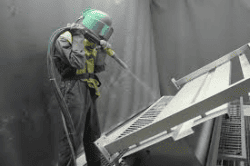A good surface preparation process begins with removing old coatings and loose materials from the material. If the surface is not clean, it will fail to hold a new coating, and that can be disastrous for the application. There are several methods for removing loose materials, including abrasive blasting, which will remove rust, flaking paint, and small pieces of masonry. Afterwards, a suitable coating preparation product should be selected and applied. For details on Surface Treatments, contact Poeton Surface Treatments
Proper surface preparation is a key factor in adhesion and can make or break a coating. Improper surface preparation can lead to orange peeling, detachment, uneven gloss, and many other problems. In addition to improper surface preparation, other environmental factors may cause the coating to fail, including air purity, cleanliness, humidity, and temperature. Improper preparation can also cause an uneven coating spread and even blistering. Depending on the environment, proper surface preparation may be determined by economic factors and the life expectancy of the coating system.
If the substrate is porous, the paint will need to be stripped away, so it is necessary to clean it thoroughly and repair any damage. A thin layer of epoxy will ensure that the surface is prepared before a coating is applied. Make sure to sand the surface before applying the coating. If there is a previous layer of varnish, it is best to strip the surface to prevent the new layer of varnish from adhesion.
Surface preparation is crucial for adhesion, durability, and lifespan of a surface coating. Different substrate materials require different surface preparation methods and adhesives. Some surfaces require only dust removal while others require elaborate surface preparation processes. So, it is important to understand the process before applying a surface coating.
Proper surface preparation will ensure the best possible adhesion and bonding. A proper surface preparation will also help prevent future problems with adhesion or limited fresh coating performance. The process will also remove uncontrolled impurities and create the necessary surface profile. When you are ready to start applying your coating, you must select the best surface preparation method for your needs.
Depending on the substrate, preparation methods will vary from project to project. For example, for non-porous substrates, the solvent wipe and two-cloth method is used to clean and prep the surface. For porous substrates, you can use abrasive blasting, pressure washing, wire brushing, and grinding. Choosing the best surface preparation technique depends on the condition of the substrate and its type.



